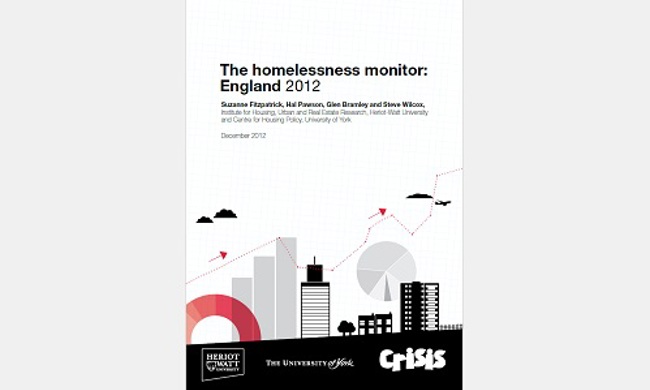The Homelessness Monitor: England 2012
06.04.2012
The Homelessness Monitor: England 2012 is the second annual report of an independent study, funded by Crisis and the Joseph Rowntree Foundation, of the homelessness impacts of recent economic and policy developments in England.
Key findings
- This is a very concerning time for homelessness in England: the simultaneous weakening of welfare protection and the housing safety net, in a context of wider recessionary pressures, is already having a negative effect on those most vulnerable to homelessness, with the prospect of much worse to come.
- ‘Visible’ forms of homelessness – including rough sleeping and statutory homelessness – are on a sharp upward trajectory in England. The national rough sleeper ‘snapshot’ count rose by 23% between Autumn 2010 and Autumn 20111 – a more dramatic growth dynamic than anything seen since the 1990s. In London there has been a 43% rise in recorded rough sleeping over the past year (though a declining proportion of new rough sleepers appear to be falling into long-term street homelessness). By June 2012, quarterly statutory homelessness acceptances in England had increased 34% on their end 2009 minimum. Temporary accommodation placements have also risen, with Bed and Breakfast hotel placements almost doubling over the past two years. There has been a particularly alarming rise in the numbers of households with children in Bed and Breakfast hotels, from 630 in March 2010 to 1,660 in March 2012.
- ‘Hidden’ forms of homelessness – including concealed, overcrowded and sharing households – have been on a long-term broadly rising trend, starting before the current recession, and reflecting mainly housing access and demographic pressures. In 2012 there were an estimated 1.54 million concealed households in England involving single people, as well as 214,000 concealed couples and lone parents. Overcrowding has increased markedly since 2003, from 2.4% to 3.0% of all households. On the most recent figures 670,000 households were overcrowded in England.
- There is marked regional divergence in these patterns, with homelessness numbers in 2011/12 expanding most rapidly in London and the South. This regional disparity suggests that housing system factors are playing an important underlying role, with rising homelessness most acute in the more pressurised South of England and less apparent in the weaker housing market context of the Northern regions.
- Possibly linked to the previous point, there is also considerable regional diversity on the causes of homelessness. In particular, while homelessness resulting from termination of assured shorthold tenancies rose by 103% across England in the two years to 2011/12, this ranged from only 11% in the North East to 156% in London and 126% in the East of England (part of the ‘South’ broad region for statistical purposes).
- In combination with the prolonged economic downturn, and the erosion of the national ‘housing settlement’,2 ongoing welfare reform seems certain to drive homelessness up yet further over the next few years. While transitional arrangements have thus far helped to mitigate the impacts of lowered Local Housing Allowance rates and national Local Housing Allowance caps, deepening benefit cuts are likely to have a much more dramatic impact on homelessness levels going forward. Linked with this, there are widespread concerns about benefit caps forcing London boroughs to ‘export’ statutorily homeless families to private rented accommodation in cheaper parts of the country.
Reference
Fitzpatrick, S., Pawson, H., Bramley, G., Wilcox, S. & Watts, B. (2012) The Homelessness Monitor: England 2012, London: Crisis.

